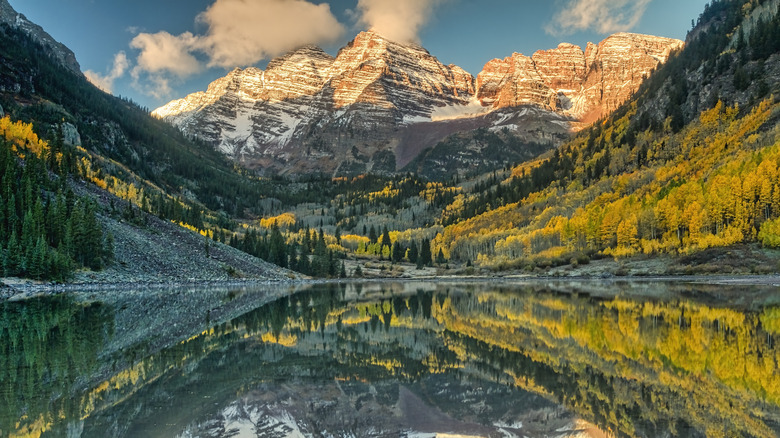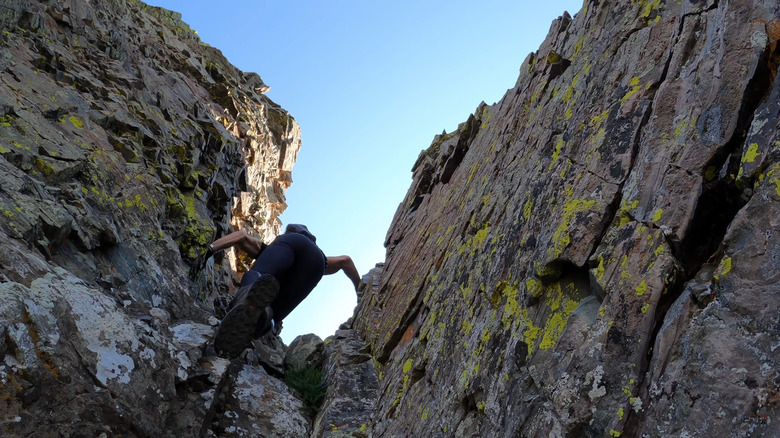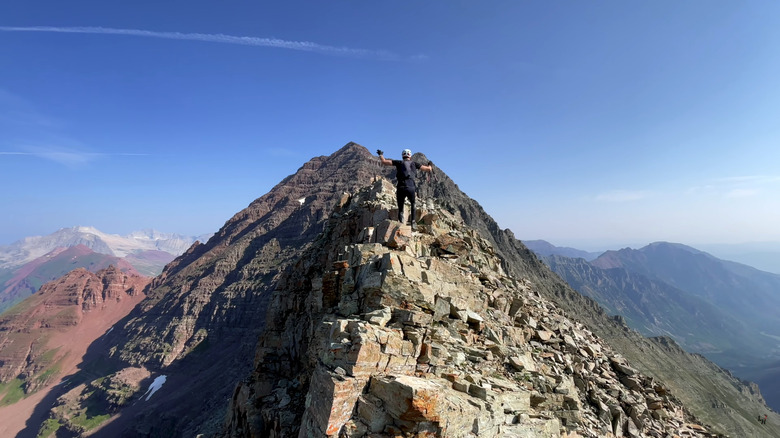Hiking This Western US Peak Is Not For Amateurs
Few mountain ridges are more iconic than the Maroon Bells of Colorado. As you approach the mountains from Maroon Lake, the valley's edges perfectly frame the shot for you: the lake in the foreground, steep foothills to the left and right, and snowy red mountain peaks cutting jagged ridges into a deep blue sky. The view is an awe-inspiring demonstration of the beauty of American landscapes. In fact, you might be so moved that you consider hiking Maroon Peak, one of two summits that make up the Maroon Bells (the other is North Maroon Peak). After all, if this is the view down here, imagine what it must be like at the top, right?
Well, before you prepare for such a trip, you should know that the Maroon Bells bear a second name ... the Deadly Bells. This is because each year, someone unfortunately passes away on these mountain peaks. That's because this isn't just a hike. Maroon Peak is one of eight "14ers" in Aspen — mountain peaks 14,000 feet and higher. It is also categorized as a Class 3 (out of 5) in terms of difficulty, meaning this route has extreme terrain that requires a lot of scrambling on your hands.
Mountaineers who take on Maroon Peak are scaling rough terrain, battling for solid ground on crumbling, rocky sediment and bracing against unpredictable and sometimes severe weather conditions. While the reward for the views is worth it, this definitely isn't an adventure to embark on lightly.
The challenges of Maroon Peak
Maroon Peak poses a few different challenges for those wanting to scale this mountainside. While the hike might only be 12 miles long, it starts at over 9,500 feet — and you'll experience a gain of another 4,800 feet. If hikers are not already acclimated to a higher elevation, they will need to spend a night or two at or above 7,000 feet to avoid altitude sickness.
Along the way, mountaineers may find it difficult to find the established route, as the ground is made up of loose rocks that may obscure the trail. You have to be experienced at identifying cairns that mark out where the trail continues. There are also several nearly vertical portions of the trail that hikers must scale to continue their ascent to the peak. The loose rocky terrain also poses a risk of both slipping and being hit by falling rocks, so helmets are highly recommended.
Finally, since much of the climb takes place above the tree line, hikers have little-to-no protection from the elements, including wind, snow, and even lightning. As such, it's recommended that hikers are back below the treeline before noon to avoid running into afternoon thunderstorms.
Preparing to scale a 14er in Colorado
To hike Maroon Peak, it's recommended that you are in decent shape and have a good amount of hiking and mountaineering experience under your belt. This hike is one of the most difficult 14er routes, so prepare appropriately and go with an experienced guide who knows this trail well if you're not 100% confident in your skills.
You should begin preparing to hike Maroon Peak for many weeks or — if you're not out hiking all the time — even months before you go. If you don't have access to trails in your area, hop on the treadmill or stair-stepper at your gym and get walking. Additionally, as we mentioned previously, if you don't live at a high elevation, be sure to acclimate a couple days beforehand. This will make your experience much more enjoyable.
Finally, the weather in Colorado during the summer is quite unpredictable. So be sure to check weather forecasts from a few different sources to get the best idea of what awaits you on the mountain. If thunderstorms are in the forecast, do not go! Similarly, if you find yourself already on the mountain and bad weather starts to move in unexpectedly, or you've reached your physical limits, turn around. The mountain will be there for you to conquer another day.


